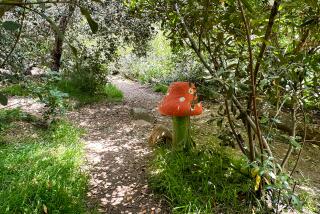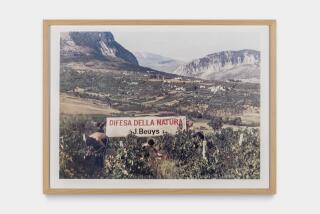Roundup: National parks graffiti, all Broad all the time, the danger of trigger warnings

Rocks defaced by graffiti in the Cap Rock area of Joshua Tree National Park. The park is one of many wilderness areas struggling to curtail vandalism.
Reviews on the new Broad museum start to land. The San Francisco Chronicle hires a new art critic. And how O.C.’s mobile home parks may be catching the eye of developers — to the detriment of retirees and the working class. Plus: Graffiti in national parks mapped, the state of the creative economy, a Postmodern maternity dress and Yelp reviews of jails.
— But first, this absolutely must-read piece in the Atlantic on why trigger warnings are bad for American education.
— The creative economy isn’t all it’s cracked up to be for fine artists, reports Ben Davis. Very few make it into art’s professional ranks.
— Orange County’s mobile home parks — long a refuge for the elderly and the working class — have caught the eye of developers aiming to take increasingly valuable land condo.
— A map of the most graffitied national parks. In related news: rock art vandalized by geology students. (Weisslink)
— Writer Greg Allen picks apart art speculator Stefan Simchowitz’s lawsuit against Ghanaian artist Ibrahim Mahama.
— The San Francisco Chronicle hires Charles Desmarais, currently the president of the San Francisco Art Institute, as its new art critic.
— The reviews are starting to come in on the new Broad museum in downtown L.A., with a pair of critiques by the L.A. Times’s Christopher Knight and New York Times’s Holland Cotter — both of whom enjoyed aspects of the new install but were less than wowed with the Broad collection’s focus on dude-heavy, market-tested art. Also, Cotter thinks the building’s skin looks like gefilte fish. (?!?!) I think if the building looks like any foodstuff, it’s spun sugar.
— An interesting profile of abstract painter Frank Stella, who will be the subject of the Whitney Museum’s first retrospective. The best part is this quote about Jeff Koons: “You know what I always thought he was like? The Franklin Mint. He’s from Pennsylvania, and he outdid them. He outshone them! It’s for very wealthy people with no taste.” Burn.
— It’s not just painting that is dead. It’s all of Western art, writes Michael Bise.
— Speaking of which, Banksy’s art may be more kitsch than satire, writes Dan Brooks.
— Plus, a forceful essay by Cathy Young on how the fight against cultural appropriation has gone too far.
— Is starchitecture turning every city into a global everyplace?
— A look back at Grace Jones’s groundbreaking Postmodern maternity dress. (All part of Dezeen’s Postmodern summer coverage.)
— 99% Invisible has a podcast on the ways the Bradbury building has been used in film.
— Military patterns as a form of land art: Boom has an interesting piece about test patterns painted onto the earth by the Air Force that allowed them to determine the scale and resolve of spy plane imagery.
— A concept camera that won’t let you shoot unoriginal photographs. Somebody please hand these out at any place serving cappuccinos.
— The Oregon-based Ursula K. Le Guin talks about writing, poetry and what drives her batty about East Coast types in Interview magazine: “I get bored with the parochialness of the East Coast. They think that the news doesn’t get out here and that people out here live in rustic ignorance of real life.”
— On the origins of the zombie.
— Yelp reviews of jails. (Citylab)
— And last but not least, a handy instructional video on how to be gluten intolerant.
Find me on Twitter @cmonstah.
More to Read
The biggest entertainment stories
Get our big stories about Hollywood, film, television, music, arts, culture and more right in your inbox as soon as they publish.
You may occasionally receive promotional content from the Los Angeles Times.











